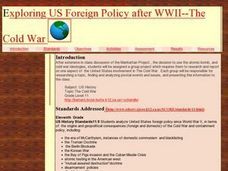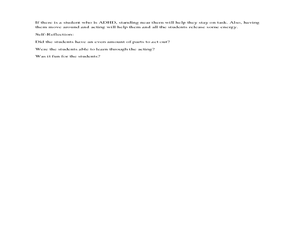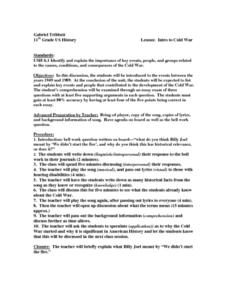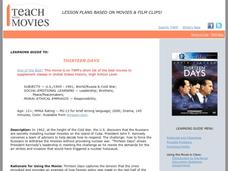Curated OER
Cold War Roots and Events
Ninth graders examine the causes and major events of the Cold War. They listen to a lecture and fill in the blanks on a handout, and in two groups develop a proposal to deal with the Cuban Missile Crisis.
Curated OER
Exploring US Foreign Policy after WWII--The Cold War
Scholars explore U.S. Foreign Policy and Cold War ideologies adopted after WWII. They conduct Internet research on a topic or issue related to the Cold War Era, watch two films, and compose a time line and a multimedia presentation to...
University of California
The End of the Cold War (1979-1991)
Scholars use primary and secondary documents, as well as video evidence, to investigate the end of the Cold War. After completing the final installment of an eight-part series, class members better understand the issues surrounding the...
University of California
Roots of the Cold War
When and how did the Cold War begin? To answer this question, you will not find a better-organized, in-depth, activity- and inquiry-based resource than this! Executing best teaching practices throughout, each portion of this inquiry...
Roy Rosenzweig Center for History and New Media
End of the Cold War
How significant was the Cold War during the 20th century? After reading and analyzing speeches by Ronald Reagan and Mikhail Gorbachev, learners consider the historical context of foreign policy decisions made during the Cold War by both...
Curated OER
Cold War Conflict in Vietnam: The Vietnam-Era Presidency
Comparing and evaluating various media types is a great way to build critical analysis skills. Learners read about the Vietnam era presidency, specifically the foreign policy established by Johnson and Nixon. Then they compare several...
Center for History Education
Cold War Case Files: The Rosenberg Trial - Was Justice Fairly Served?
The Rosenbergs—executed for their role in a Soviet-era spy ring—continue the captivate the American imagination. Using a history lab format, young historians examine the trove of documents associated with the case, including photographs...
Curated OER
The Origins of the Cold War, 1945-1949
Students investigate the early years of the Cold War and the origins of containment. Both supporters as well as critics are probed to examine the differences that emerged in the months following the end of the war in Europe. This unit...
Curated OER
The Cold War: Solving the Mystery of History with Voices on Vinyl
Eighth graders explore the Cold War Era. In this world history lesson, 8th graders discover the positions taken by countries during the Cold War as they listen to lectures regarding the major events and turning points in the Cold War....
Curated OER
The Cold War And Beyond
High schoolers interview an adult that grew up in the United States during the Cold War to develop an understanding of the concept of mutually assured destruction. They focus the interview on how the person dealt with the threat of...
Curated OER
Eisenhower: The Cold War
Students participate in a news conference simulation. In this Cold War lesson, students research events of the conflict during Eisenhower's presidency and use the information to script and participate in a news conference with Eisenhower.
Carolina K-12
NATO: After the Cold War
Why was the North Atlantic Treaty Organization (NATO) formed, and what is its mission? Learners discuss NATO's participation in various events throughout the Cold War and work in groups to analyze whether those responses were appropriate.
Stanford University
Cold War in Guatemala
Students investigate the Cold War and why it was fought in Guatemala. In this Cold War lesson, students analyze documents from the CIA and textbooks then discuss. Students work in pairs to answer questions and fill out graphic organizers.
Curated OER
The United States and the Soviet Union were Engaged in a Cold War
Students work together at figuring out the definition for what cold war means. In this social science lesson, students listen to "The Butter Battle Book" by Dr. Seuss and recognize how this story relates to the cold war between the...
Curated OER
Introduction to the Cold War
Students examine the domino theory. In this cold war lesson, students watch a video about dominos and then get into groups that represent different nations. Students will then act out a mock simulation of the containment and domino theory.
Curated OER
Intro to Cold War
Eleventh graders are introduced to the events between the years 1949 and 1989. They list and explain key events and people that contributed to the development of the Cold War. Students are asked "what do you think Billy Joel meant by...
Curated OER
Cold War
Eleventh graders analyze U.S. foreign policy since World War II, tracing origins and geopolitical consequences (foreign and domestic) of the Cold War and containment policy.
Curated OER
Cold War Era Film Censorship: High Noon- a Slice of Americana Or Communist
Students study of the effects of the Cold War on the home front. They analyze the film High Noon according to an abbreviated version of the standards that films were judged by in the early 1950s and determine whether or not High Noon is...
Curated OER
America and Canada: The Post Cold War Era
Students discuss the provoking question, "What does the term social change mean?" They discuss the social changes taking place during and following the Cold War. Students participate in a short discussion, they are presented with facts...
Curated OER
Hitting the Cold War From All Angles
Eighth graders use maps, lecture and research to explore the history and social context of the Cold War. They examine films, music and important figures of the era.
Smithsonian Institution
The Soldier’s Experience—Vietnam versus World War I
The Vietnam War and World War I were two very important—and different—wars. To understand the differences, and similarities, class members watch videos, examine primary source documents, and then create a newscast that examines the...
Teach with Movies
Learning Guide to Thirteen Days
While Thirteen Days is a fantastic film to use in the classroom in reference to the Cold War and the Cuban missile crisis, it is important to take care to effectively and properly incorporate its contents into your curriculum. This...
Center for History Education
Guatemalan Coup of 1954: How Did the Cold War Influence American Foreign Policy Decisions?
Was it all about the bananas—or the fear of a communist threat? Young historians use a history lab to examine documents from the American-led 1954 Guatemalan coup. Using graphics, government documents, and speeches, they examine the...
University of California
The Vietnam War (1945 – 1975)
Have you ever wanted to do something so perfectly you wound up not doing it well at all? Young historians use primary and secondary documents to analyze the United States involvement in the Vietnam War. The issues surrounding the...
Other popular searches
- The Cold War
- Cold War Political Cartoon
- Cold War Map
- Cold War Timeline
- Space Race Cold War
- End of Cold War
- Cold War Lesson Plans
- Origins of Cold War
- Events of the Cold War
- Cold War Leaders
- End Cold War
- Canadian History Cold War

























